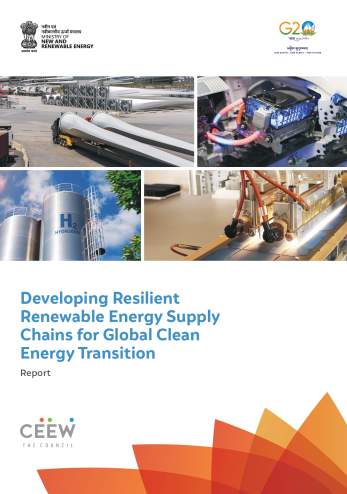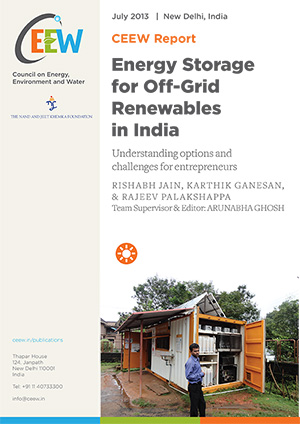Report
Energy Storage for Off-Grid Renewables in India
Understanding options and challenges for entrepreneurs
Rishabh Jain, Karthik Ganesan, Rajeev Palakshappa
July 2013 | Technology Futures
Suggested Citation: Jain, Rishabh, Karthik Ganesan and Rajeev Palakshappa. 2013. Energy storage for off-grid renewables in India- Understanding options and challenges for entrepreneurs. New Delhi: Council on Energy, Environment and Water.
Overview
Energy storage is important to tap renewable energy in an efficient manner because of the intermittent nature of renewable energy sources. This report examines the available storage technologies in India and discusses challenges faced while moving towards more efficient technologies. Further, it identifies points of engagements for the Renewable Energy Working Group (REWG) as a forum to collectively push for innovations in the policy framework for off-grid renewable energy.
It is expected that by 2020, off-grid renewable energy market will make up 1/3rd of the market potential for energy storage systems in renewable energy applications in India. Currently, off-grid entrepreneurs are faced with storage choices that are largely driven by cost. The report also discusses potential points of intervention that may help establish environment friendly and cost-effective energy storage systems for off-grid entrepreneurs.
Key Highlights
- Most off-grid renewable energy products and systems are in the range of a few Watts to a few hundred kW, and rely on batteries as storage technology.
- Technologies such as Pumped Storage Hydro (PSH), which represents nearly 99% of the bulk storage capacity in the world, and Compressed Air Energy Storage are not suited for small-scale renewable energy systems due to their scale requirements.
- Scale of implementation and maturity of technologies play an important role in the choice of the appropriate technology. Off-grid entrepreneurs must balance these factors when choosing a storage technology, but often their choices are driven by upfront costs.
- Off-grid renewable energy storage is primarily used for solar power-based home systems in rural areas, lighting and charging solutions or roof-top solar applications in urban areas.
- Off-grid renewable energy applications account for only 10 to 12 per cent of the overall demand for energy storage by the year 2020.
- Given the combination of scale and cost constraints faced by off-grid entrepreneurs, battery storage becomes a de-facto choice.
- Lead acid batteries have been commercially used for over a century and are the most mature technology available. Though these batteries are low cost and have high reliability, they have drawbacks in the form of heavy weight, short life, regular maintenance requirement, low energy density and even the occasional health hazard from acid-fumes.
- Lithium-ion batteries offer the best energy density (upto 630 Wh/l), efficiency (90 per cent) and durability with low self-discharge rates (5 to 8 per cent per month at 21°C). However, Li-ion batteries are still expensive at round USD 500 per kWh and there is some way to go before complete safety of the battery has been established.
- In the absence of a commercial alternative, the Ministry of New and Renewable Energy has recommended lead acid batteries. Most batteries lose crucial life cycle when used at ambient. It is necessary to choose a battery that performs well in the local conditions, especially the maintenance-free varieties.
- Challenges such as short life, after sales maintenance and heavy weight pose a major drawback for battery storage solutions. These challenges may be overcome if technologies such as nickel batteries, lithium-ion, lithium air, fuel cells, etc. become commercially viable.
Factors to be taken into account while choosing storage technology

Key Recommendations
- Create a differentiated incentive mechanism to broaden the market for battery-based storage and shift away from the current dominance of lead acid storage.
- Improve compliance among consumers in furthering environmentally sound practices when it comes to recycling. Ensure that the customers are motivated to use accredited suppliers as well as certified recyclers.
- Actively promote the innovation and research & development in battery technology, specific to off-grid consumers.
Role of the REWG
- Push for a stringent regime on environmental impact monitoring, where consumers and manufacturers may face penalty on non-conformance.
- Work towards the establishment (and enforcement) of performance benchmarks on battery manufacturers.
- Serve as a platform to understand potential new business models that could open up using alternative battery technologies.
Challenges such as short life and heavy weight of battery storage solutions, may be overcome if technologies such as nickel batteries, lithium-ion, lithium air, fuel cells, etc. become commercially viable.











